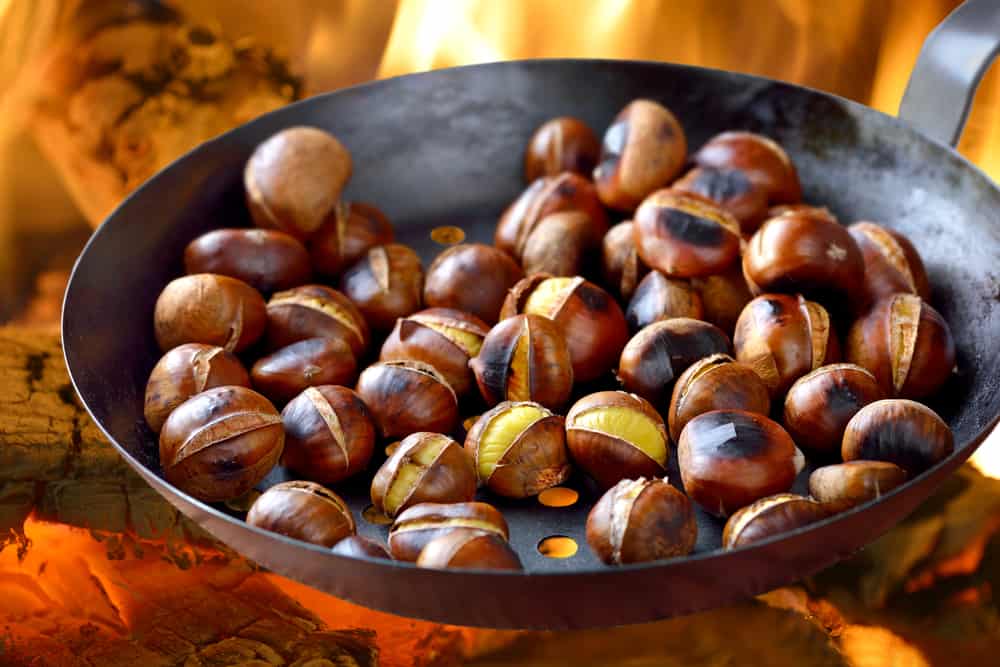Last Updated on 17th December 2021 by
I don’t know about you, but roasted chestnuts make me think of Christmas time, and not just because of the popular song that starts with a line about them. They are also a favorite treat of mine during that time of year.
Do you really need to roast them on an open fire, or is there a better way to prepare chestnuts? When they’re raw, chestnuts have a slightly bitter taste, but cooked chestnuts produce a more delicate flavor profile.
This is actually a dish you can make in your
Chestnuts are traditionally roasted over an open fire, though. You can do that on your stove top, if you have a gas burner stove. You also need a roasting
How to Roast Chestnuts in the Oven
Let’s start with the simplest way to cook the chestnuts, and that would be using the
Start by preheating your
Using a cutting board and an appropriate knife (either a chef’s knife or a paring knife), make a cut in the shape of an X on the side of each chestnut that is most rounded. You don’t want to skip this step, as it helps the chestnuts not explode when you cook them.
When roasting chestnuts, internal pressure can push outward and burst them. Cutting the chestnuts like this also makes them easier to peel when they’re done cooking.
Place your chestnuts onto a baking sheet or baking rack. Once the
They may need a little longer than that in the
After the chestnuts have finished roasting, you can take them out of the
After they have cooled for a couple minutes, you can open up the towel and pull off the dark shells on the outside of the chestnuts. You should see yellow-white chestnuts underneath. As you peel, be sure to get rid of the thin, papery skin next to the flesh of the chestnut.
How to Roast Chestnuts on the Stove Top
For the traditional roasted chestnuts smell and taste, you’ll have to use your stovetop or an open
You’ll be able to use a lot of the same methods for roasting chestnuts on the stove top that you do when roasting them in the
When cooking chestnuts on your stove, be sure to place them X-side down in the
When the chestnuts have finished roasting, you should peel them right away. They will probably be very hot to the touch, so you can use a towel to help you.
It’s important that you use a low heat as you cook on the stovetop. This ensures that the chestnuts cook all the way through and that you don’t end up with an overly soft outer layer of nutmeat and a tough, impenetrable inner layer.
There’s no way to really speed up the process, even if you were to cover the roasting
The chestnut roasting
What to Do If You Find Worms in the Chestnuts
When you see small, round holes in the chestnuts, these are probably from worms hiding inside. You can either discard these or soak them in water. Allow the chestnuts to soak in water for about 20 minutes, keeping the temperature at 120 degrees Fahrenheit. This will kill the worms inside the chestnuts and make the nuts safe to eat.
Weevil larva like to hide out inside the chestnuts, making their home there. Be sure to check your chestnuts over carefully before roasting them so that you don’t actually ingest some weevil larva.
Make sure you soak the chestnuts in water before roasting them.
Another thing to look out for is that you choose the right kind of chestnuts. If you’re gathering them on your own, avoid horse chestnuts, since they are toxic.
Chestnuts are pretty easy to find in groceries and food markets close to Christmas time. They are typically harvested in the autumn, so you can start seeing them in stores about the same time that the leaves change color.
If you want to try out some chestnut recipes before Christmas time, the fall is an excellent time to start looking for them. You can try your hand at chestnuts and see what kind of recipes you can make with them before the true test comes when you serve them for Christmas dinner.
You’ll find that they’re fairly easy to cook with, but they do take a while to cook in the
They can cook just fine on their own without being disturbed. In fact, when roasting chestnuts on the stovetop, you want to leave them with the X facing downward. Otherwise, they won’t cook properly.
I'm Pauline, a mother of four grown children, my passion for cooking stemmed from the joy i get cooking for my family. I love to try new dishes, especially when dining out but creating and sharing my own recipes is my favourite thing to do!



binance anm"alningsbonus
Thursday 13th of June 2024
Thanks for sharing. I read many of your blog posts, cool, your blog is very good.